| CRICKET
BATS ARE MADE OF WILLOW. IT IS TO BE
EXPECTED THAT THE CONDITION OF THE BAT
WILL DETERIORATE DURING ITS USAGE. THE
MANUFACTURERS HAVE PUT TOGETHER THE
FOLLOWING NOTES TO ASSIST THE EXPLANATION
OF SITUATIONS WHICH MAY OCCUR WITHIN THE
LIFESPAN OF ANY CRICKET BAT. |
BREAKAGE
1. HANDLE BREAKS
CAUSE - General wear and tear
SOLUTION - The bat itself is not
replaceable, but the handle may be
repaired at the MANUFACTURERS discretion. |
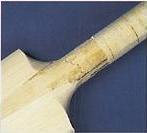 |
2.
BREAKAGE TO THE BLADE
CAUSE - Weak or excessively dry willow.
SOLUTION - Potentially replaceable by full
or partial credit, at MANUFACTUERS'
discretion |
 |
BLADE
DAMAGE
1. SURFACE CRACKING TO THE FACE OF THE
BLADE
CAUSE - General wear and tear
SOLUTION - NOT REPLACEABLE, crack will not
affect the performance of the bat.
Repairable at the MANUFACTURER'S
discretion. |
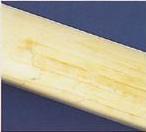 |
2.
SURFACE CRACKING TO THE EDGE OF THE BLADE
CAUSE - General wear and tear
SOLUTION - NOT REPLACEABLE, crack will not
affect the performance of the BAT.
Repairable at the MANUFACTUER'S discretion |
 |
3.
SURFACE CRACKING TO THE TOE OF THE BLADE
CAUSE - general wear and tear. This type
of damage is often caused by the striking
of a "yorker" delivery and/or
excessive tapping of the crease.
SOLUTION - NOT REPLACEABLE, crack will not
affect the performance of the BAT.
Repairable at the MANUFACTURER'S
discretion. |
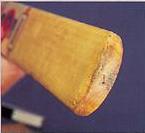 |
4.
SPLIT THROUGH THE TOE AREA OF THE BLADE
CAUSE - This type of damage is caused by
the striking of a ball at, or near the
base of the blade, e.g. the driving of a
"yorker"
SOLUTION - Repairable and/or replaceable
at the MANUFACTURER'S discretion |
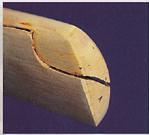 |
5.
CRACKING TO THE SHOULDER OF THE BLADE
CAUSE - General wear and tear
SOLUTION - NOT REPLACEABLE, repairable at
the MANUFACTURER'S discretion. |
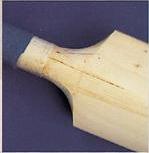 |
6.
DAMAGE DUE TO MISUSE OF THE BAT OR BY
ACCIDENT
CAUSE - Generally caused by accidentally
striking an object other than the ball,
for example the stumps.
SOLUTION - NOT REPLACEABLE, may be
repairable at the CUSTOMER'S expense.
|
|
MOISTURE
DAMAGE
CAUSE - this type of damage occurs as a
result of use in damp or wet conditions.
It generally leads to swelling of the toe
area of the blade, which after drying may
well split.
SOLUTION - NOT REPLACEABLE, there is no
fault in the manufacturing or the
materials used. The damage may be
repairable at the MANUFACTURER'S
discretion and the CUSTOMER' S cost.
|
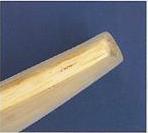 |
DAMAGE
DUE TO THE USE OF POOR QUALITY CRICKET
BALLS
Poor quality or excessively hard cricket
balls can be a cause of many types of
crack damage to the blade of the bat, as
previously illustrated.
ALL CRICKET BAT MANUFACTURERS recommend
that only balls of reputable manufacture
are used. Use of any other style or type
of ball may cause damage to bats and WILL
affect any claim made.
|
|
GENERAL
INFORMATION
1. CRICKET BAT WILLOW - English
willow (Salix Caerulea or Alba Var) is by
nature a soft fibrous reed. Performance
and durability are enhanced by drying and
pressing. In normal usage willow will
become bruised, scarred or dented simply
due to the nature of the game (the impact
with the ball.) The performance of the bat
will not be affected. Such marking can
occur at any time during the lifespan of
the bat.
2. KASHMIR WILLOW - Willow grown
overseas is by its very nature much harder
than English willow. Therefore bats made
of this type of willow will not have a
comparable level of performance with
English willow bats.
3. RETURNS - All repairs or
discounts given on replacement bats are at
the discretion of the MANUFACTURER. Bats
returned under complaint MUST be
accompanied by proof of purchase
(including date of purchase). Failure to
comply may affect the customer's statutory
rights.
4. LIFESPAN OF A CRICKET BAT -
There can be no definitive length of time
that a cricket bat will last. The
condition of a bat deteriorates with use.
The length of time before the player needs
to replace his bat will depend upon:
a) The amount of use
b) The weight of the bat (heavier blades
tend to be more durable than lighter ones)
c) The care with which the bat is treated
5. AGE OF THE CRICKET BAT - Bats
over TWELVE months old (from the date of
purchase) will be considered entirely at
the manufacturer's discretion, taking into
account the age and condition of the bat.
It is possible for the condition of the
bat to deteriorate even without use
(simply due to the natural drying out
process).
6. IN CASE OF DAMAGE - Immediate
action should be taken. This normally
necessitates withdrawal from play whilst
repairs are carried out. It is vital the
repairs are carried out by professional
bat makers. The manufacturers are unable
to guarantee repair work carried out by
non-approved repairers.
7. STORAGE - To ensure that a vat
remains in good condition it is essential
that it is not stored in excessively warm
conditions (e.g. near to central heating).
This will cause the bat to dry out and
precipitate future problems. The bat
should ideally be stored in a position
that will allow a little of the moisture
from the atmosphere to be absorbed.
PREPARATION FOR PLAY
The CRICKET BAT MANUFACTURERS recommend
the following principles for the
preparation and maintenance of cricket
bats.
Following these procedures will
significantly reduce the possibility of
damage occurring.
OILING
All natural faced bats MUST be treated
using raw linseed or a specialist cricket
bat oil. The main purpose of oiling is to
maintain moisture levels within the blade,
and hence reduce the chances of cracking
and splitting.
Light coats should be applied to the face,
edge, toe and back of the blade, taking
care to avoid the logos and splice area.
Generally two or three coats should be
sufficient. Each coat should be allowed to
dry into the blade, which should be kept
in a horizontal position before the next
is applied.
WARNING - DO NOT OVER OIL
DO NOT STAND THE BAT IN OIL
DO NOT LEAVE THE BAT IN A VERTICAL
POSITION AFTER OILING
BATS WITH FULL PROTECTIVE COATINGS SHOULD
NOT HAVE OIL APPLIED, BUT THEY MUST BE
CONDITIONED AS DETAILED BELOW
ALTERNATIVELY - It is possible to
fit a clear Anti-scuff or similar cover.
This does not negate the requirement to
"knock-in" the bat. The cover
may assist the durability of the bat, but
under no circumstances will it totally
prevent surface damage.
KNOCKING-IN
All bats are pressed, however,
"knocking-in" is VITAL. This is
the process by which the fibres of the
willow in the face and edges are
compressed together to form a barrier that
protects the bat against the impact of the
ball. Effective "knocking-in"
will significantly improve the performance
and increase the lifespan of the bat.
STAGE ONE
The "knocking-in" process should
be undertaken carefully using a special
bat mallet or an old quality cricket ball.
The bat should be repeatedly struck (with
gradually increasing force) in all areas
where one would normally expect to hit the
ball. This conditioning must be performed
with patience. Particular attention should
be given to the edges, although the edges
or toe should not be struck directly at
right angles to the blade. This would be
likely to cause damage.
This stage should take in the region of
six hours, although it may vary, as every
bat is different.
STAGE TWO
The next step is to graduate to the use of
the bat to hit short catches with an old
quality cricket ball. However, if the seam
marks the blade it is necessary to return
to "stage one" for further
conditioning. This stage should be
performed for at least another hour.
Once these steps have been taken, the bat
should be ready for use in matches. It is
advisable to initially avoid use against
the "new ball".
In addition to these steps it is
recommended that the purchaser follows
closely the "bat care"
instructions issued by the manufacturer.
WARNING
UNDER NO CIRCUMSTANCES SHOULD A BAT BE
USED IN MATCH CONDITIONS LESS THAN TWO
WEEKS FOLLOWING THE DATE OF PURCHASE. |
